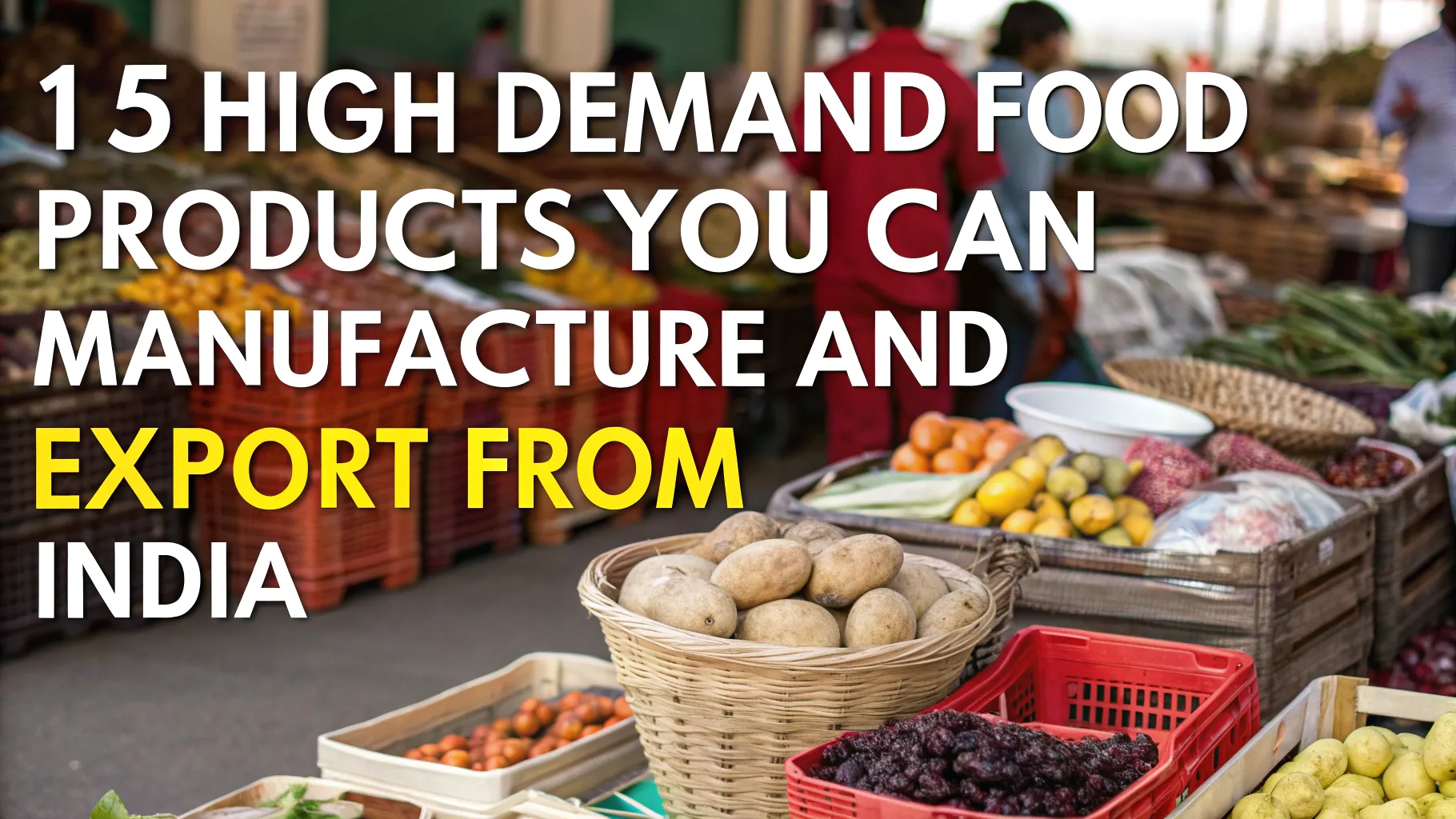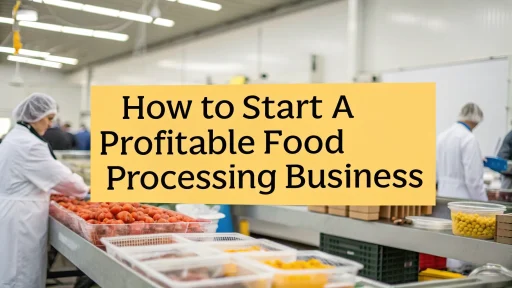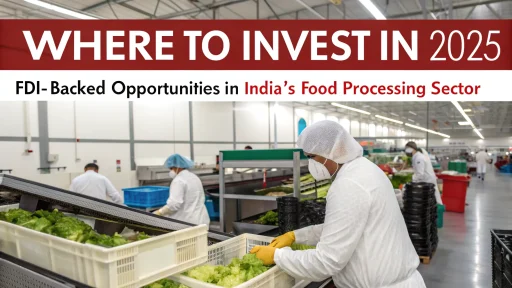Food processing is one of the most promising sectors for Indian entrepreneurs. With ample raw materials and generous government backing, India’s food exports reached USD 46.43 billion in FY 2023-24, constituting around 11.7% of total exports. The sector has been growing faster than agriculture, averaging 5.35% annual growth over the past 8 years, compared to 4.46% for agriculture. This is due to increasing global consumption of Indian value-added foods, which fuels innovation in manufacturing. Indeed, the export of processed foods has increased substantially, rising to 23.4% of the value of agri-food exports in 2023-24 compared to 18.1% in 2018-19. The MoFPI aims to foster this growth by making investments and offering incentives, as well as catering to the domestic and global markets through schemes that promote food processing.
Related: Top 10 Government Schemes for Food Processing Startups in India
Government Assistance and Industry Growth Predictions
Policies like PMFME (Pradhan Mantri (PM) Formalisation of Micro and Small Food Processing Enterprises) and One District One Product (ODOP) are fueling food startups in India. Each district has a food commodity focus, like watermelon and muskmelon in Telangana, turmeric in Odisha, banana in Tamil Nadu, and onion in Maharashtra. This serves to build export-oriented clusters. Similarly, the PLI (Production Linked Incentive) Scheme for the Food Processing Industry focuses on certain segments such as Ready to Eat and Ready to Cook meals, including those made from millets, processed fruits and vegetables, seafood, and more to make “global food manufacturing champions.”
These initiatives, together with the rising disposable incomes of the middle class and the global focus on health, especially in emerging markets, are creating an abundant opportunity for quality food.
This article covers the 15 unique food products and categories entrepreneurs in India can produce and export. Each of these offers strong international demand along with extensive growth opportunities. Also, we will discuss the growth forecasts, market drivers and the reason these are promising new business opportunities. Let’s explore!
In FY 2023-24, India exported the following top 10 agri-food products: Basmati rice, spices, and buffalo meat leading the charge.
1. Basmati Rice – Exquisite Aromatic Rice In Global Markets
Indian basmati rice is one of the flag ship products of the country. Widely accepted for its exquisite aroma and long grains, Indian basmati rice is wish listed in several countries including Middle East, Europe and USA. The exports for basmati rice during FY 2023-24 shot up to nearly 5.94 billion dollars, which is a growth of over 22% year on year. Even with non-basmati rice export restrictions to safeguard domestic food reserves, the demand for basmati abroad continues to be strong. As highlighted in the MoFPI Annual Report 2023-24, rice continues to be one of the largest segment of foods exported from India which continues to be in demand.
From a business point of view, modern rice milling and export offer tremendous profit opportunities. India is the world’s second-largest producer of rice and is naturally suitable for basmati cultivation. There is an opportunity for entrepreneurs to invest in modern rice mills to grade, polish, and package basmati rice for export. Optimistic market forecasts suggest that global demand for specialty rice will increase due to rising populations in emerging markets and new clientele for premium basmati. The export of basmati rice not only generates foreign exchange, but also connects Indian farmers to global supply chains, thus supporting India’s objective of increasing farmers’ incomes.
2. Spices (Chilli, Turmeric, Cumin, etc.) – India’s Spice Treasure
India is often called the land of spices, as it has been supplying spices all over the globe for centuries. For the 2023-24 fiscal year, spice exports were projected to reach approximately $4.23 billion, a 14% increase year over year. This encompasses chilli, turmeric, cumin, pepper, cardamom, and even cinnamon. Indian spices account for roughly 12% of the world’s spice exports which indicates a significant value in market penetration. There is high demand not only from the Indian diaspora, but also from International interest in spices for food, health reasons, and nutraceutical benefits. As an example, turmeric is sought after as a health supplement due to its active ingredient curcumin, and food manufacturers on a global scale are interested in using chilli peppers for natural flavoring and coloring.
Entrepreneurs can start spice processing units by cleaning, grinding, powdering, and packaging spices to international standards. Packaging such as spice blends and retail packs adds more value compared to simple exports of raw spices.
The Government’s One District One Product (ODOP) scheme focuses on nurturing specific districts which are richly abounding in spices, for example, Byadgi chillies in Karnataka and Erode turmeric in Tamilnadu, thus creating local opportunities which new businesses can tap into for local collaboration and raw material sourcing. Internationally the market for spices and seasonings is on the rise and is expected to reach USD 34 billion by 2030 growing at a healthy CAGR of 5-6% driven by organic and exotic trends.
By investing in spice processing and maintaining quality in ASTA cleanliness and ISO food safety standards, Indian startups have the opportunity to thrive during the boom. Indian spices, when complemented with proper quality control, will continue to dominate the kitchen cabinets of households across the globe.
3. Tea – India Gardens’ Famous Brew Around the World
Tea is another significant product in which India has a global presence. In 2024, India’s tea exports reached an all-time high of 255 million kg valued at $924 million, a 10% increase from the previous year. Indian tea has a market in over 25 countries, among them the traditional ones like Russia, the UK, UAE, and Iran as well as newer ones like Canada and Australia. Assam and Darjeeling teas are popular across the globe for their unique taste. The Tea Board of India and MoFPI are actively working to boost tea exports through marketing and quality enhancement initiatives. For example, there is a plan to motivate youth from tea-growing regions to become professional tea tasters to preserve quality.
For an entrepreneur, the tea processing and export business is a promising opportunity. It includes sourcing tea leaves from auctions or estates, blending, packing, and exporting under a private label. There is increasing international demand for value-added certified organic teas, flavored teas, or herbal teas like masala chai and tulsi green tea. Government schemes can assist with tea marketing under ODOP in Assam and West Bengal. Moreover, the PLI scheme focusing on branding can help build strong Indian tea brands abroad. Forecasts show steady growth in global tea consumption, particularly for premium and health-oriented teas. India holds around 10 percent of global tea exports with a great deal of room for growth. Starting a tea export business focused on ethically sourced and environmentally friendly teas along with attractive packaging will ensure success.
Related: Launch Your Profitable Food Processing Business
4. Coffee – Emerging Niche of Specialty and Instant Coffee
Though not as well-known for coffee, India does have a reputation for specialty coffees such as Monsooned Malabar and instant coffee. India’s coffee exports grew by around 12% YoY, reaching approximately $1.29 billion in FY 2023-24. Other important markets include Italy, Germany, and Russia for Indian robusta and instant coffee, as well as some emerging Asian economies. Players investing in processing units located in Karnataka and Andhra Pradesh have led to the growth of an instant coffee industry and have also improved the export of value-added coffee instead of raw green beans.
Entrepreneurs can participate in coffee processing by exporting cured and roasted coffee beans or even making instant coffee granules. The government has established the Coffee Board to assist the industry, and SMEs can also innovate by venturing into coffee-related products such as flavored coffee and coffee concentrates. A person looking to start a coffee export business could collaborate with local coffee cooperatives for raw material supplies and purchase roasting or grinding machinery for value-added exports. The business prospects look promising as coffee remains one of the top ten export food commodities.
5. Fresh and Processed Fruits (e.g. Mango, Banana)
India is the world’s second-largest fruit producer and a noteworthy exporter of certain fresh fruits and processed fruit products. There is great demand internationally for mangoes, bananas, grapes, pomegranates, and apples. India’s FY 2023–24 fresh fruit exports are projected at $1.16 billion—a 21 % year‑on‑year rise led by mangoes and bananas—while demand also grows for processed products like pulp, juices, jams, and dried fruits. Exports of processed fruits and juices were about $1.09 billion in FY 2024. Their demand often exceeds supply during peak season. Cold chain and ripening infrastructure improvements are also aiding in increasing exports of bananas.
Ventures in the processing and export of fruit begin with some level of export processing. Exporting fresh fruits requires a supply chain that includes sorting, grading, vapor‑heat pest treatment, and cold storage. These are some of the requirements to import to US and Japan. Government bodies like APEDA support market access for fruits such as recently permitting Indian mangoes to new markets.
Another way is to produce fruit pulps and concentrates. India is the leading producer of mango pulp imported into the United States and European countries in juices and yogurts. A fruit processing unit can target bulk buyers overseas or retail consumers with branded products.
Rising global demand for tropical fruits—mangoes (for vitamin A) and pomegranates (for antioxidants)—is boosting investment in India’s fruit export sector. Contract farming ensures quality cultivation, leading to modernized processing and packaging and making Indian fruits year‑round staples in overseas supermarkets.
6. Vegetables and Vegetable Products (Examples: Onions, Processed Veg)
There is untapped potential in perishable items such as vegetables. India exports a considerable amount of fresh vegetables, and the country has witnessed remarkable growth in this area. Fresh vegetable exports reached $891 million in FY 2023‑24. This marked an astonishing 144 percent increase over the previous year. Onion is one of the leading exports and India stands as one of the top onion exporting countries. In addition, pickles, sauces, purees, and frozen vegetable products offer more value-added exports for India. India exported $1.15 billion of prepared vegetables, fruits, and nuts in FY 2023‑24. This category includes pickles and mixed vegetable curries. This reflects the growing trend of selling enhanced value products.
Entrepreneurs can set up a vegetable processing unit to dehydrate produce. This extends shelf life and yields products like dried onion flakes. They can also freeze mixed vegetables for longer storage. They can also produce curry pastes and pickled vegetables for the diaspora market. Government support is strong. The Operation Greens scheme began with tomatoes, onions, and potatoes. It has now expanded to include other crops.
There is increased demand from emerging markets for certain Indian value-added or fresh vegetable products like off-season ready-to-cook curry bases. Startups can use cold‑chain technology and strict quality control to meet global vegetable demand while minimizing waste. India’s abundant production supports strong demand for processed onions, with products like fried onion paste and onion powder selling worldwide. There is also increasing demand globally for pickles and ethnic sauces as people adapt to Indian spices. India’s processed vegetables and exports are integrated and remain untouched for advancement within the industry.
7. Buffalo Meat, Poultry, and Eggs
Meat exports in India have risen, driven by buffalo meat. India is now a leading exporter of carabeef. Its demand in Asia, the Middle East, and Africa is due to its competitively priced lean meat cuts. Export earnings for buffalo meat in FY 2023-24 are estimated at $3.72 billion, placing it as the third highest agri-food export revenue of India.
Moreover, India stands out as one of the leading exporters of bovine meats globally. In addition, exports of poultry products and eggs are on the rise due to increased demand for processed halal chicken cuts and halal eggs from neighboring countries and the Middle East. For example, the MoFPI’s programs support the establishment of modern abattoirs and meat processing plants under international standards.
While exploring opportunities in meat processing for export, an entrepreneur should be weighs the heavy initial investment against the profits it could yield. Some prerequisites are following international sanitary and phytosanitary measures (which includes disease testing and cold chain maintenance) and obtaining halal and HACCP certifications. Specialty cuts, frozen meats, and even ethnic market-ready meals such as sausages or other value-added processed meats are additional focuses for new units.
The PLI scheme also covers free-range eggs, egg products, and poultry meat which suggests government focus on innovation and development of these industries. Coupled with farmers producing healthy livestock to support backward integration, India’s meat exporters can significantly grow with modern processing facilities. It’s important to also highlight the job opportunities this generates and the impact it has on the peripheral supply chain (feed, logistics, cold storage) which aids in the development of the region.
8. Marine Products – India’s Blue Economy Export Strength
Marine products have been India’s top agro-based export sector and includes seafood such as shrimps, fishes, and mollusks. India is now one of the leading providers of frozen shrimps in the world, especially for the USA. Recently, the marine products exports have been around $6-$7 billion every year. This value reached an all-time high in FY 2022-23 when it was $6.82 billion, but then fell to $6.12 billion in 2023-24 due to market shifts. The coastal aquaculture industry in Andhra Pradesh and Odisha has also transformed the industry with the demand for L. Vannamei shrimp. Other marine product exports include surimi fish, pomfret, tuna, cuttlefish, squid, and crab. To assist the sector, the Marine Products Export Development Authority MPEDA has them supported with laboratories for checking the quality of the products.
For entrepreneurs interested in exporting marine products, there is an opportunity to establish seafood processing plants. These operations usually include the freezing and packaging of seafood as well as the manufacturing of ready-to-cook products such as breaded shrimp and fish fillets. There’s an also a shift towards greater diversification, for example, moving from the export of raw frozen blocks to the export of processed fish products which capture greater value.
The global demand for seafood rich in proteins continues to grow, especially in markets that prioritize health and high-protein diets. India’s seafood products are also gaining newer markets outside the US, such as East Asia and Europe (China recently increased imports of Indian marine products). Proximity to the coast as well as a reliable marine sourcing network is essential, in addition to stringent regulatory compliance like the US FDA and EU marine product regulations. Still, this remains one of the most lucrative segments for food exports due to high export returns and government aid (for example, duty benefits under certain trade agreements). Investing in branding and technology (cold chain logistics, IQF freezing) allows startups to take advantage of the boom in “blue economy” exports.
9. Dairy Products (Milk Powder, Ghee, Cheese)
India tops the list of milk producers globally; most of its production is consumed domestically, but exports have room for growth with the right marketing approach. Exports include skimmed milk powder (SMP), ghee (clarified butter), butter, processed and non-processed cheese, along with specific traditional products. During the year of 2023-2024, exports were not very high. Dairy exports were modest at $624 million, but there was a significant increase in the previous year. There is growing foreign demand for Indian dairy products, especially ghee and butter in the Middle East, and milk powders in Asian and African countries with scarce supplies. There is also a demand among the diaspora for ethnic Indian products like paneer and khoa.
Dairy exporting can be a lucrative opportunity for entrepreneurs as it involves creating value-added, long shelf-life products which are easy to transport. One example would be milk powder, which requires constant supply of quality milk as well as installation of spray drying facilities.
Another area is targeting health focused international buyers with organic or A2 dairy products. French free trade agreements along with government policies like export subsidies from the National Dairy Development Board can create wider opportunities for Indian dairy. The World Bank estimates that the Asia and Africa regions, where local production cannot keep up with demand, create a greater gap for Indian firms to exploit. There’s also room for startups to further market exported UHT and flavored milk products, as some domestic companies have begun doing, considering these have a longer shelf life. While strict import country food safety regulations demand strong quality control, India’s abundant surplus milk during peak seasons makes this economically beneficial.
10. Ready-to-Eat and Convenience Foods
Indian cuisine is growing as the world experiences a noticeable increase in the demand for Ready-To-Eat (RTE) and RTC (ready-to-cook) products. Examples of these foods include instant meals, curry pastes, frozen Parathas, spice mixes, instant noodles, and canned or retort-packaged foods. Some Indian companies now export microwaveable curries and dehydrated meal kits like biryani mix. They serve both the diaspora and foreign food enthusiasts. These products fall under Preparations of cereals/flour and Miscellaneous edible preparations. Together, they garnered over $2.2 billion in exports in FY 2023‑24. HS 21, covering many RTE products, earned $1.41 billion that year. This reflected 10 percent year‑over‑year growth and showed strong momentum in packaged foods.
Starting a business that manufactures RTE (Ready to Eat)/RTC (Ready to Cook) foods comes with many opportunities. One can consider making frozen ready meals like curries, rice dishes, or even samosas. Additionally, regional specialties can be stored in retort pouches which are shelf-stable. Category‑1 PLI schemes incentivize manufacturing of Ready‑to‑Eat (RTE) and Ready‑to‑Cook (RTC) meals, including millet‑based products. These projects qualify for financial incentives under the scheme. The approval of 12 major RTE/RTC food companies under PLI demonstrates the government’s growing focus on packaged meals. Emerging markets located in Asia and Africa also now tend to import Indian cooked food.
Authentic taste, preservation technology (to ensure long shelf life without refrigeration), and attractive packaging all add to the competitive edge. There is already international competition with Indian paste and spice brands. There is also room for new entrepreneurs using global health trends like low-oil snacks or even millet noodles that are healthy and ready-to-eat. These products will align with global wellness trends. Today, a small factory can establish themselves as a global brand with proper marketing. With government-sponsored incubation and food parks, gaining technical knowledge, like packaging technology, has become a lot easier.
11. Indian Snacks and Namkeens
The world of Indian snacks (namkeens, extruded snacks, chips, etc.) is crispy and savory, finding admirers around the globe. Chickpea and bhujia snacks along with poppadums are especially popular products among the Indian diaspora and now international consumers are also trying them out. In FY24, India’s exports under the category of miscellaneous processed items (which also include snacks) stood at $1.65 billion. In recent times, larger Indian snack companies have begun setting up international distribution networks, and even smaller brands like those selling gluten-free millet or roasted snacks are exporting their goods.
Indian ethnic sweets and chocolates can also be mentioned here, like Soan papdi or gulab jamun mix and chocolate bars. The export of sugar and sugar confectionery experienced a significant boost in FY23 and FY24 with over $9.6 billion total. While these products are currently under export restrictions, it showcases how much can be exported when restrictions are lifted. Processed snack exports don’t have this restriction and so can freely increase exports.
Snack food exporters can capitalize on opportunities such as automated fryers for namkeens, roasting lines for nuts, or confectionery machinery for candy production. Preserving the authentic taste of the product and keeping it fresh during long-distance shipping (nitrogen-flush packaging, etc.) is crucial. Innovations like baked, quinoa, or millet based snacks and healthier versions of traditional snacks are appealing to health-conscious consumers. The government promotes food processing clusters, such as Mega Food Parks, which offer cold storage and packaging facilities for snack exporters. Indian diaspora populations in North America, Europe, and Australia are increasing, which drives demand for Indian snacks.
These products are also becoming available at international supermarkets in the world food aisles. The outlook for the global market for savory snacks is positive (CAGR of over 5% for the next 5 years). Snack manufacturers can build a profitable export business by focusing on strong branding and meeting international standards. They must use only approved artificial dyes and ensure proper labeling.
12. Bakery and Biscuits
Biscuits, cookies, and rusks have been cracking quietly India’s success in exports for a while now. Widely Parle brands like Gluc Biscuits, Marie and Sunfeast Cookies have also been serving the international market. Their popularity stems from their readily available prices and their taste tailored for both Indian and international consumers. This also overlaps the snack category. Apart from biscuits, companies can export cakes, naan, and frozen chapati. They can also target niche markets with gluten‑free and vegan breads. Chocolates and candy also fall under confectionary which are India’s expanding chocolate industry focused on.
Starting a bakery unit for exports can require low capital when producing basic biscuit lines. Advanced ovens and automated packaging lines, however, demand higher investment. Regardless, even small to mid-sized bakeries in India have found success exporting to neighboring countries and ethnic grocery stores abroad. Contract manufacturing for foreign brands allows companies to leverage India’s lower production costs. Market forecasts for India‑made biscuits in Asia and Africa indicate high growth potential due to urbanization and Westernized diets.
Government support is available through export promotion councils and the PLI scheme. Biscuits and snacks qualify as Ready-to-Eat foods under these programs. For instance, millet-based cookies could benefit from the India millet promotion campaigns. With rising costs for ingredients, maintaining efficiency is critical. However, industrial ovens and mixers do improve output. Entrepreneurs can develop unique international flavors, such as mango biscuits or almond‑honey cookies, to stand out on store shelves. The bakery segment blends high volume with innovation. With the right strategy, it offers strong export potential.
Products From Millet – The Super Grains are Going Global
Millets are traditional Indian grains such as jowar, bajra, ragi, and foxtail millet. They are now celebrated as “super grains” for their high nutritional value and low environmental impact. With the UN declaring 2023 the International Year of Millets, there’s a great impetus to popularize millet-based foods globally. India, as the largest producer of millets, is leading this effort. Exports of millets, both as raw grains and value-added products, have started to increase. For example, many millet product companies recently participated in international trade fairs to showcase their products. Millets are classified as coarse cereals and contribute to India’s cereal exports. The government is marketing them overseas as nutri‑cereals and positioning India as a leading supplier of millets and millet‑based products such as flours, mixes, and snacks.
Manufacturing products from millet is a growing niche for startups. Possible export products include millet flour and ready‑to‑cook meals like khichdi. Manufacturers can also offer millet cookies, noodles, and breakfast cereals. Even malted health drinks made from millets have strong export potential.
Under the PMFME scheme’s One District One Product focus, Karnataka and Maharashtra have designated millets as district products. There is an anticipated increase in the global demand for millets as consumers look for alternatives to wheat and rice. These states also offer assistance for setting up millet processing units. Developing markets in Africa and the US/EU are targets. Entrepreneurs can set up processing units to dehull, clean, and process millets to make “nutri-cereal” products. Processed millet exports have significant growth potential. This supports India’s effort to brand millets as a gift to the world for sustainable diets.
Organic and Health Foods (Including Organic Staples, Superfoods)
“Organic” is a buzzword all around the world. India has a wide variety of agriculture which gives it an advantage in the organic foods segment. Organic staples such as rice, spices, tea, and coffee are in high demand. Superfoods like Isabgol (psyllium husk), flaxseeds, moringa products, and quinoa attract export interest. Herbal supplements have growing popularity. Functional foods, including protein mixes and Ayurvedic health powders, also show strong export potential. The global organic food market is growing as more consumers are purchasing chemical-free and sustainably produced food. India’s organic product exports have risen steadily, backed by APEDA’s National Programme for Organic Production (NPOP) certification. NPOP ensures that farms meet organic standards before exporting their produce.
When starting an organic food export business, entrepreneurs must get necessary certifications like India Organic, USDA Organic, or EU Organic depending on the target market. The business model may include contract organic farming, processing, and packaging for export. Examples include units that grind organic spices. Organic rice mills and facilities for herbal supplements—such as moringa capsules or amla juice—are also viable. The government’s Production Linked Incentive scheme backs innovation in organic food processing. It provides incentives for creating new organic products. Moreover, nutraceuticals and health supplements made from food are emerging industries in India with export potential. Many startups are already marketing Ayurveda-inspired drinks and turmeric lattes internationally.
These products are supported by government agencies which help in navigating foreign compliance. The demand outlook is strong, as an example, the global organic spices market is estimated to grow at a rate of 4-5% CAGR through 2030. By blending India’s wellness traditions with modern compliance and presentation, these startups can capture a high-value niche market. The focus should be on quality and storytelling. Whether it is organic basmati rice or a gluten-free flour blend, international consumers love a compelling tale about the origin and benefits of their health foods, and Indian exporters have plenty to share.
For more information check our related videos on Food Processing
Honey and Natural Sweeteners (Jaggery)
Glistening at the top of the list is honey and sweeteners used traditionally, like jaggery. India exports honey from eucalyptus and wildflower plants along with forest honey, especially from Punjab. This honey is shipped to countries in the US, EU and Middle East, which assists India in being one of the top 10 honey exporters in the world. With the focus on natural sugars globally, India’s exports of natural honey is on the rise.
The government aid through initiatives such as National Beekeeping & Honey Mission has increased the quality and quantity of honey produced in India, which is why thousands of tons of honey is being exported every year. For example, during the financial year 2022-23, India exported natural honey worth 79 million dollars according to APEDA data. Since people are more cautious about their health nowadays, honey is expected to be in demand, but the product needs to be high quality (unadulterated, residue-free, and pure honey is a must to pass import checks).
In the same manner, jaggery and molasses, which is unrefined sugar from palm or sugarcane, is becoming more popular for people seeking healthier options to refined sugar. India exported jaggery and confectionery worth $358 million in the year 2022-23. While these numbers tend to fluctuate with sugarcane production, there is a strong upward trend concerning jaggery consumption. Certain startups have already begun to sell liquid jaggery, jaggery powder, and even jaggery-based candies externally, using jaggory’s image as “superfood sweetener” to it’s advantage.
Starting a honey processing, packaging unit or a jaggery production unit can be highly beneficial for an entrepreneur. Honey processing includes gathering honey from beekeepers, light heating/filtration, and packing. Although honey processing is relatively simple and low-tech, quality assurance testing is essential. While jaggery manufacturing is more traditional, modernized (evaporators, molding machines) versions that increase output and consistency are available.
Both honey and jaggery fall under the purview of MoFPI’s food processing schemes and can gt support. For instance, honey processing is explicitly mentioned as an eligible sector in food processing schemes. There’s also convergence with initiatives like ODOP (some districts focus on honey) and the One District One Product list includes various sweeteners. Global market forecasts for natural sweeteners predict robust growth as consumers move away from refined sugar. By focusing on purity and possibly obtaining organic or fair-trade certifications, Indian honey and jaggery exporters can command premium prices. Satisfying the world’s sweet tooth is deceptively simple – the business opportunity is anything but.
Conclusion: Maximizing Export Opportunities With Sufficient Assistance
The food export business demands one to grasp global market trends in addition to possessing the necessary skills for food quality production. The 15 products listed above reflect strong opportunity areas for India. It is crucial for entrepreneurs and new businesses entering in these areas to capitalize on India’s strengths of primary raw materials such as the country’s horticulture and livestock alongside government schemes that cater to food processors. Watching over market demand and trends such as the need for health and convenience will be beneficial. With proper investment in branding and packaging as well as adhering to international standards (ISO, FSSAI, Codex, etc.), ensuring compliance will help in establishing a successful export business.
Firstly, and as previously stated, feasibility studies are important for any manufacturing-export unit as they help determine practicality. Here is where dedicated professionals like Niir Project Consultancy Services (NPCS) come in to provide professional help. For instance, they prepare Market Survey cum Detailed Techno-Economic Feasibility Reports for different businesses which NPCS has helped set up across India. To assist entrepreneurs gauge the viability of setting up an industry, these reports help identify all processes involved such as manufacturing processes, raw material requirements as, and, financials.
NPCS’s expertise helps food startups assess the feasibility of their alternative product lines, navigate regulatory frameworks, and decision-making.







